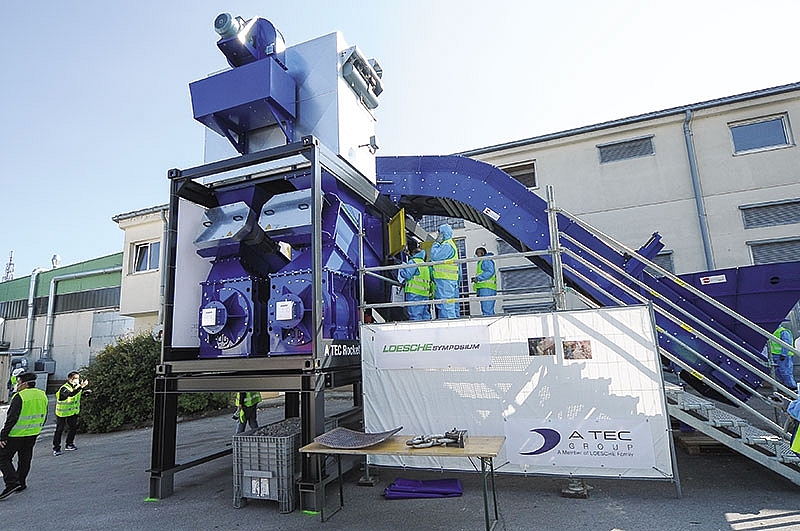New prospects for cement in waste-to-fuel
 |
| German firm Loesche will present its solutions for cement plants at a symposium on August 22 in Hanoi |
The cement industry has made significant contributions to processing waste from industrial factories. Many types of waste, such as blast furnace slag, slag and fly ash from thermal power plants, pyrite slag, and gypsum recovered from chemical plants, are used as raw materials and additives in cement production.
Clinker furnaces have a very high temperature (between 1,450 and 2,000 degrees Celsius), and are suitable for processing hazardous waste from medicine and chemical facilities and oil refineries, according to the Vietnam Association for Building Materials (VABM).
A cement plant usually consumes 3,000-6,500 million joules of fuel per tonne of clinker produced, depending on the raw materials and the process used. It has been reported that the costs associated with fuel in a cement plant can be as high as 30 to 40 per cent of the total production costs.
Meanwhile, every year, 15 million tonnes of living waste are collected, nearly 80 per cent of which goes to landfills and only about 20 per cent is treated by incineration or recycling. If this continues, it will be very difficult to find landfills, especially as urban areas are expanding across the country.
“Therefore, if cement plants are involved in the waste treatment process, it will bring about great benefits to society in how we treat the environment and by recovering the energy that is currently lost due to waste going straight to landfill,” said Tong Van Nga, chairman of the VABM.
Using alternative fuels will help reduce energy costs and provide a competitive edge for cement plants. This will benefit the plant
economically and environmentally, improving its sustainability and reducing the burden of waste disposal considerably.
To discuss this issue and create co-operation opportunities for building materials companies, VABM will host a symposium themed “Processing waste to alternative fuels for cement industry” on August 22 at the Grand Plaza Hotel on 117 Tran Duy Hung street in Hanoi’s Cau Giay district.
At the symposium, representatives of corporations in the cement and environment industry, state agencies, and institutes will discuss the potential uses of alternative fuels in cement plants to reduce the industry’s carbon dioxide emissions with Germany’s Loesche GmbH. Discussions will also be focused on the potential use of alternative fuel, especially urban solid waste in the cement industry.
“Loesche GmbH has already transferred technology, provided machinery, and co-operated with Vietnamese mechanical companies to reduce power and heat consumption,” Nga said.
“I believe that they will succeed in processing waste to alternative fuels to replace original fuels in the cement industry,” he said.
The symposium will cover many issues, including the monitoring process; the relationship between the production process and the quality of the product as well as the quality of the gas emitted to the environment.
Besides, the event will also delve into other issues, such as the supervision procedures of the competent authorities for collection, reception, processing, and burning in the cement kiln system; and the necessity of an appropriate legal framework to encourage the effective application of this type of technology.
What the stars mean:
★ Poor ★ ★ Promising ★★★ Good ★★★★ Very good ★★★★★ Exceptional
 Tag:
Tag:
Related Contents
Latest News
More News
- TECHFEST Vietnam 2025 links startups with policy and capital (December 15, 2025 | 18:21)
- MST to allocate $3.8 billion for sci-tech in 2026 (December 15, 2025 | 18:10)
- Long Thanh International Airport welcomes first Vietnam Airlines test flight (December 15, 2025 | 18:01)
- Health Innovation Hub: accelerating health equity through digital healthcare innovation (December 15, 2025 | 08:00)
- Vietnam’s first AI Law to take effect from March 2026 (December 12, 2025 | 09:00)
- Chi Communications joins SEA CAN alliance (December 11, 2025 | 17:39)
- New Law on High Technology sets incentives and safeguards (December 11, 2025 | 09:00)
- IBTE 2025 to return to Ho Chi Minh City this December (December 11, 2025 | 09:00)
- Masan posts steady gains as Vietnam targets stronger retail growth (December 10, 2025 | 18:58)
- Seafood exports to Japan surge towards new annual record (December 10, 2025 | 18:50)
























 Mobile Version
Mobile Version